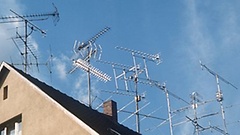Navigationspfad: Homepage > Press > Parliamentary Television
How to receive Parliamentary Television
Parliamentary Television via Web TV
The German Bundestag’s Parliamentary Television channel is broadcast online via Web TV. This means it is possible for viewers to watch the current Parliamentary Television output, as a live stream, on their computer screens. All that is required is an ISDN, modem (46 KBit/s) or DSL (514 KBit/s) connection. Just click on the link below to start watching.
Parliamentary Television via Cable
The Parliamentary Television channel can be received unencrypted throughout Berlin via Kabel Deutschland’s digital cable network, channel S32 (394 MHz). If a change in the channel line-up results in viewers no longer receiving the channel, we recommend that they use the automatic channel search function. Viewers who have questions or reception problems should contact their cable provider.
Parliamentary Television via Satellite
The Parliamentary Television channel can be received unencrypted via the Astra 3B satellite at 23.5 degrees east.
The following settings apply from 1 May 2012 onwards:
| Transponder |
3212 |
| Frequency |
11,934 MHz |
| Polarisation |
Vertical |
| Symbol rate |
27500 |
| FEC |
3 / 4 |
| DVB-S2 |
8 PSK |
With effect from 1 May 2012, viewers need an HD satellite receiver that can decode DVB-S2 signals to receive Parliamentary Television. However, Parliamentary Television continues to be broadcast in standard definition.
Parliamentary Television ceased broadcasting at its previous frequency of 11,973 MHz on 30 April 2012.
Anyone who is interested in watching Parliamentary Television via satellite needs a satellite dish pointed at 23.5 degrees east. In Germany, satellite television is normally received via dishes aligned to 19.2 degrees east, so viewers will either need a second dish or what is known as a duo or twin LNB (low noise block-downcoverter) which can receive signals from both positions.
Video on demand
The German Bundestag’s video-on-demand service makes it possible to watch previously broadcast Parliamentary Television programmes whenever you want and as many times as you want. The video requested is streamed directly from the Internet and not stored on the user’s local computer. An internet connection is required for this service. Video on demand is offered in two different formats:
- a low-resolution format for internet connections with an analogue modem or ISDN
- a high-resolution format for DSL and other broadband connections


